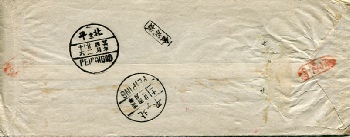
Cliquez sur les images pour agrandir -

LETTRE
20 avril 1937 -
–
April 20th, 1937 -
|
Dimensions : |
84 x 216 mm |
|
|
Tarif : |
Lettre pour la Chine, par 20g…… Recommandation………………. Avis de réception……………….. Total……………………………… |
5 fens 8 fens 5 fens 18 fens |
|
Période de valeur : |
1/04/1937 au 28/02/1942 |
|
|
Timbre utilisé : |
YT n°46 |
|
|
Oblitération : |
N°41.1 Ling Yuan 20/04/1937 |
|
|
Période d’utilisation : |
24/01/1936 au 14/11/1944 |
|
|
Indications : |
Étiquette de recommandation (utilisée du 13/04/1937 au 01/04/1944). Cachet « Recommandé avec AR » bilingue chinois- |
|
|
Arrivée : |
Oblitération Pékin 22/04/1937 |
|
|
Size : |
84 x 216 mm |
|
|
Rate : |
China letter, per 20g……………. Registration fee………………… Return receipt………………….. Total…………………………….. |
5 fen 8 fen 5 fen 18 fen |
|
Period of rate : |
04/01/1937 to 02/28/1942 |
|
|
Stamp : |
SG n°50 |
|
|
Postmark : |
N°41.1 Ling Yuan 04/20/1937 |
|
|
Period of use : |
01/24/1936 to 11/14/1944 |
|
|
Instructions : |
Registration label (used 04/13/1937 to 04/01/1944). Hanstamp « Registered with AR » bilingual Chinese- |
|
|
Arrival : |
Postmark Beijing 04/22/1937 |
|
A l’inverse de la lettre du 13 avril pour Tientsin, cette lettre est affranchie avec un timbre à l’effigie de Puyi et portant la mention « Administration postale de l’empire mandchou ». Ceci n’est pas conforme à l’accord postal sino-
Ce type de cachet -


Unlike the letter to Tientsin dated April 13th, this letter was franked with a stamp bearing the effigy of Puyi and the words "Postal Administration of the Manchu Empire". This was not in accordance with the 1934 Sino-
This type of postmark -